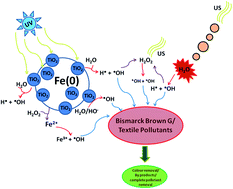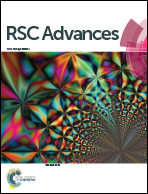Sonophotocatalytic treatment of Bismarck Brown G dye and real textile effluent using synthesized novel Fe(0)-doped TiO2 catalyst†
Abstract
Using the novel Fe(0)-TiO2-doped catalyst, the degradation of Bismarck Brown G dye was compared by means of advanced oxidation processes, such as sonolysis (13 mm and 25 mm probe tip diameters), photolysis (UV light) and sonophotolysis. The effect of the initial dye solution pH, H2O2 concentration, gas bubbling (argon, oxygen, air and nitrogen), dye concentration and reaction volume were studied. Understanding the degradation mechanism from these studies, the Bismarck Brown G dye treatment was further intensified by catalytic treatments, such as commercial TiO2, synthesized Fe(0) and synthesized Fe(0)-doped TiO2 under sonolytic, photolytic and sonophotolytic irradiations. SEM, TEM, XRD and DRS characterization studies of the sonolytically synthesized catalyst shows that they were of uniform shape, nanoscale in size and had good absorption properties. Among the processes studied, sonophotocatalytic treatment of Bismarck Brown G dye in the presence of Fe(0)-doped TiO2 showed the highest colour removal with the smallest amount of catalyst addition and for larger reaction volume. The practical applicability of the synergistic effects with real textile effluent signifies that the studied process is highly efficient for a safer environment.


 Please wait while we load your content...
Please wait while we load your content...